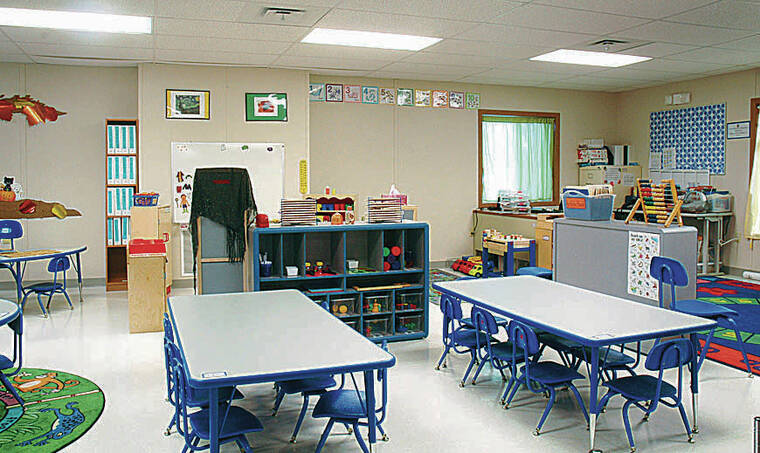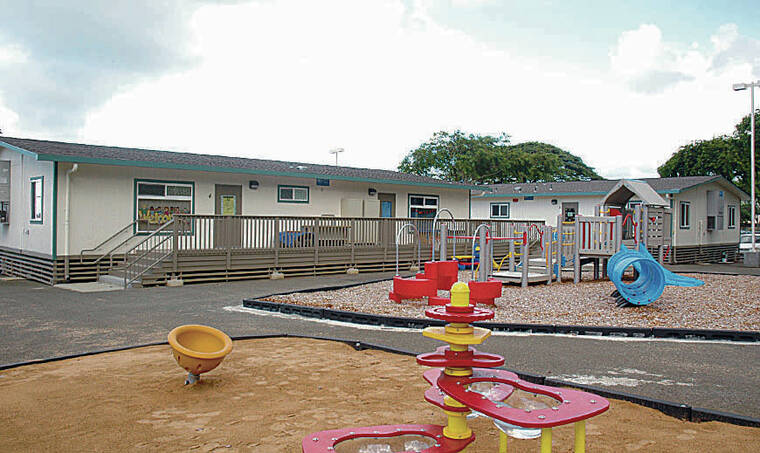As the state embarks on its ambitious plan to offer universal access to preschool by creating 465 new classrooms by 2032, among the questions stakeholders are asking most is, How will so many additional preschool teachers be found in the midst of the state’s chronic teacher shortage?
Complicating the matter are questions about whether 3- and 4-year-olds ought to be taught separately; if so, what credentials, pay levels and union representation would apply for teachers of each age group; and whether historically low-paid preschool workers will see pay rise to levels that attract and keep more in the profession.
Lt. Gov. Sylvia Luke last week unveiled the “Ready Keiki” plan to create universal preschool access for all of Hawaii’s 3- and 4-year-olds by 2032. Of the state’s 35,272 children in those age groups, only a little over half are being served by prekindergarten classrooms, 95% of them in private licensed institutions. Figuring that 20% of the remainder will typically opt out, Luke says, the state is aiming to provide preschool access for 9,297 more keiki. Students at public preschools would attend at no cost, she said.
“A significant number of the kids are not going to preschool because the parents cannot afford it or it’s not accessible near where they live,” Luke said Friday in an interview on the Honolulu Star- Advertiser’s “Spotlight Hawaii” livestream program. “And when you think about it that way, it’s really a social injustice issue.”
The plan to create 465 classrooms, at 20 children a classroom, uses multiple public, private and philanthropic strategies to get 80 new classrooms ready to welcome preschoolers by August 2024, and approximately 50 more new classrooms each following year. Luke said in an update that she’s in talks to see whether at least some of the first round of classrooms could be opened this fall instead.
The Legislature appropriated $200 million to be spent by June 20, 2024, to kick off construction, but millions in added building costs is expected.
And each of the 465 classrooms likely will require at least one teacher and one teaching assistant.
Shortage persists
But Hawaii’s public school system, like many schools systems nationwide, has long suffered a persistent shortage of teachers. As of Dec. 1, Hawaii’s public schools had 737 teacher vacancies — about 6% of the total positions, according to state Department of Education data.
Luke said that she has been told by Hawaii education officials that the local teacher shortage is “mostly at the high school level and specific subject matters, and it’s not so much at the pre-K elementary (level).”
She added that according to her team’s research, there are “potentially about 1,000 available teachers with an early-education degree” enabling them to teach preschool to third grade, “and we’ve identified about 100 teachers who can potentially work right now.”
When the state Department of Education was asked to confirm those numbers, DOE Communications Director Nanea Kalani responded by email, “My understanding is that Lt. Gov. and her team have identified potential teachers including current teachers, recent graduates and retired teachers. Strengthening our workforce pipeline is something we will need to collectively work on with all partners.”
Swelling retirements and resignations during the COVID-19 pandemic haven’t helped the teacher counts. There were 1,230 voluntary resignations by Hawaii public school teachers in the 2021-2022 school year, compared with an average of 1,071 per year in the school years 2017-2018 to 2020-2021, according to state Department of Education data.
The National Education Association, the largest teachers union in the country, has called the nation’s teacher shortage a “five-alarm crisis,” and estimated at the start of the school year that the U.S. is short about 300,000 teachers and support staff.
Graduates needed
Many education leaders agree that Hawaii’s teacher colleges will have to ramp up their numbers of graduates if there is to be an easing of the existing teacher shortage while meeting the increased demand that the new preschools will create.
The University of Hawaii Manoa College of Education, for its part, will need to gradually raise its production of graduates from the current 350 per year to 500 or more, said its dean, Nathan Murata. And it will need to look at increasing from the few dozen among them each year who specialize in early-childhood education, he said.
Murata said he is heartened by what he believes is an unprecedented level of momentum and cooperation happening among public, private and philanthropic entities to grow the local pipeline of teachers.
For instance, there are robust conversations to institute “teacher academies” with teaching preschool classrooms on all 10 University of Hawaii classrooms and some local high schools; Luke has said Waipahu, Nanakuli and Mililani have volunteered, for starters.
“These will not only be preschools to provide services for the community, but these will be teaching (career) pathways so that students can go into the classroom, have practical experience and real experience,” Luke said.
Murata said better articulation agreements also are being developed so that students can more easily move from getting their two-year associate degrees at the UH community colleges to working in the coming preschools while continuing to study for a four-year education degree.
Other local institutions that Luke has said are being called on to increase production of teachers include UH West Oahu and the private Chaminade University. Kalani noted that the DOE draws teachers also from Hawaii Pacific University, Brigham Young University Hawaii and the Teach for America program.
However, the retention rate of Hawaii public school teachers after five years on the job stood stubbornly at just over 50% at last report.
“We can recruit ad nauseam, but if there’s a hole in the back of a barrel of water leaking, we’ll never fill it up,” Murata said.
The state in recent years has stepped up marketing and recruitment, Murata noted, and lawmakers approved $164 million in 2022 to ease salary “compression” as well as pay differentials for hard-to-staff positions.
A culture change along with such pay changes will be needed to coax a larger number of young people to enter teaching, Murata said. “I think with the recruitment, with the marketing, with the compensation packages … I think we’re changing to a matter of seeing teaching as truly a profession that people can be proud of. I think we can get there, slowly. We are on a good path.”
Luke said she also expects trickle-down effects of a planned request for $40 million to increase tuition subsidies that low- and moderate-income families can receive through the state’s Preschool Open Doors program to send their children to private preschools. Currently, the subsidies are available only for 4-year-olds, but the request would add 3-year-olds and raise the subsidy amount. Luke said the hope is that the money will encourage those private schools to increase preschool teacher hiring and pay levels.
Expanding private preschools is important because some can offer extended hours past the typical early-afternoon dismissal of public schools, Luke said. “One of the things that is attractive for a parent or working parent … is to make sure that you can drop off your child as early as 7 a.m. and have the flexibility to pick your son or daughter up as late as 6 p.m.,” she said.
Low pay scrutinized
How public and private preschools in Hawaii will compensate employees is of high interest because preschool teacher and child care workers in Hawaii and nationwide have traditionally been poorly paid.
The U.S. Bureau of Labor Statistics defines preschool teachers and child care workers as different types of workers with different qualifications (see accompanying graphic). Median pay for a preschool teacher with a two-year degree was $30,210 per year in 2021, while child care workers earned even less.
However, the handful of teachers already teaching the 943 students in preschool classes under Hawaii’s state Executive Office on Early Learning and public charter schools are already on the same HSTA contract and pay schedule as K-12 licensed, qualified teachers with four-year degrees.
The average salary of a Hawaii public school teacher in grades K-12 in 2020-2021 was $70,922, according to National Education Association data.
Generally speaking, “if you want to get the most highly qualified people (to become teachers), you have to show them that you respect what they do, and compensate them accordingly,” Hawaii State Teachers Association President Osa Tui Jr. said.
But the HSTA asserts that different types of services are needed for 3-year-olds versus 4-year-olds. That could have ramifications for how their teachers are paid and who would be included in the existing collective bargaining agreement between HSTA and the state. Educational assistants, who typically have two-year degrees, are represented by the Hawaii Government Employees Association on a lower pay scale.
“Three-year-olds would be considered like day care, and that’s not something that HSTA would represent,” Tui said. “It’s when they become 4-year-olds — that’s when they would be under our highly qualified preschool teachers” and come under HSTA’s current contract.
There are also statutory considerations. Luke has said the Executive Office on Early Learning will be the operational arm of the public preschools. But when Yuuko Arikawa-Cross, director of the Executive Office on Early Learning, was asked whether the age groups might be combined in the state’s public preschools, she said that preschools under her office are obligated by statute to serve only 4-year-olds. She noted that public charter schools offering prekindergarten serve both 3- and 4-year-olds, but there are only 11 of them doing so.
WHAT PRESCHOOL WORKERS EARN
Preschool teachers
>> Job description: Educate and care for children younger than age 5 who have not yet entered kindergarten
>> Typical entry-level education: Associate’s degree
>> National median: $30,210 per year, or $14.52 per hour
>> Hawaii annual mean wage: $38,140 to $55,960
Child care workers
>> Job description: Attend to children’s needs while helping to foster early development
>> Typical entry-level education: High school diploma or equivalent
>> National median: $27,490 per year, or $13.22 per hour
>> Hawaii annual mean wage: $25,720 to $29,710
Source: U.S. Bureau of Labor Statistics, 2021




